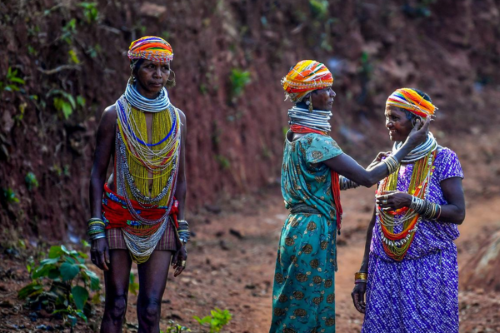Date : 12/12/2023
Relevance: GS Paper 2- Social Justice- Particularly Vulnerable Tribal Groups (PVTGs)
Keywords: Particularly Vulnerable Tribal Groups (PVTGs), Pradhan Mantri-Janjati Adivasi Nyaya Maha Abhiyan (PM-JANMAN) scheme, National Advisory Council (NAC), Tribal Sub-Scheme (TSS)
Context-
- The Particularly Vulnerable Tribal Groups (PVTGs) in India, initially referred to as Primitive Tribal Groups, are communities facing unique challenges such as declining or stagnant population, use of pre-agrarian technology, economic backwardness, and low literacy.
- Despite being spread across 18 States and Union Territories, PVTGs are often found in remote and inaccessible areas, making them some of the most vulnerable among the Scheduled Tribes.
- The recent developments, challenges, and initiatives aimed at the holistic development of PVTGs, with a focus on the Pradhan Mantri-Janjati Adivasi Nyaya Maha Abhiyan (PM-JANMAN) scheme.
Understanding PVTGs:
- In India, the tribal population constitutes 8.6% of the total, with Particularly Vulnerable Tribal Groups (PVTGs) facing heightened vulnerability within this demographic. Due to their precarious situation, more developed tribal groups receive a significant share of tribal development funds, leaving PVTGs in greater need of dedicated financial support.
- The Dhebar Commission in 1973 identified Primitive Tribal Groups (PTGs) as a distinct category of less-developed tribes. In 2006, the Indian Government renamed PTGs as PVTGs. In 1975, the government initiated the identification of the most vulnerable tribal groups, declaring 52 such groups. In 1993, an additional 23 groups were added, bringing the total to 75 PVTGs out of the 705 Scheduled Tribes.
- PVTGs share common characteristics such as homogeneity, small population size, physical isolation, lack of a written language, simple technology, and a slower rate of change. Odisha is home to the highest number of the 75 listed PVTGs.
Divergent Census Data:
- Contradictory information on the population trends of PVTGs has emerged, creating a discrepancy between the data provided by the Ministry of Tribal Affairs to a Parliamentary panel last year and the recent statement from the Tribal Affairs Ministry to the Rajya Sabha.
- While the former indicated a nearly 40% decline in PVTG numbers in nine States and Union Territories during the first decade of the century, the latter claimed that the population was not in decline.
Pradhan Mantri-Janjati Adivasi Nyaya Maha Abhiyan (PM-JANMAN) Scheme:
- The Indian government, acknowledging the challenges faced by PVTGs, recently approved the ₹24,000 crore PM-JANMAN scheme.
- The scheme, an extension of the PM-PVTG Development Mission, aims to bring basic facilities like roads, power, homes, and mobile connectivity to the most backward among the Scheduled Tribes.
- The scheme outlines a multifaceted approach to address the diverse needs of PVTGs. The allocation includes ₹19,000 crore for building pucca homes under the PM-AWAS scheme and laying 8,000 km of connecting roads. Implementation involves nine ministries, each responsible for specific aspects such as healthcare, education, infrastructure, and connectivity. The goal is comprehensive development that addresses the multifaceted challenges faced by PVTGs.
Challenges and Data Deficiency:
- One major hurdle in executing the PM-JANMAN scheme is the lack of current and comprehensive data on PVTGs.
- Despite efforts by the Ministry of Tribal Affairs to conduct baseline surveys and assess village needs, there is a notable absence of recent demographic and socio-economic data.
- The Parliamentary Standing Committee on Social Justice and Empowerment has highlighted this data deficiency as a critical issue.
Historical Data Gap:
- The absence of specific Census data for PVTGs since 1951 is a glaring gap.
- The government's failure to conduct separate Censuses for these groups, as recommended by a 2013 National Advisory Council (NAC) report, has impeded the formulation of targeted policies.
- Such data would not only enumerate the population but also provide insights into education, health, and housing status.
Role of Ministry of Tribal Affairs:
- While the Tribal Affairs Ministry is a key player in the development of PVTGs, its budget allocation for 2023-24 reveals a modest ₹256.14 crore specifically earmarked for these communities.
- The majority of the ₹24,000 crore allocation goes towards building homes and roads, managed by the Ministry of Road Transport and Highways.
Other Government Schemes
- The Ministry of Tribal Affairs administers the "Development of Particularly Vulnerable Tribal Groups (PVTGs)" Scheme exclusively designed for these groups. Within this initiative, Conservation-cum-Development (CCD)/Annual Plans are formulated by each State/UT based on the specific needs of their PVTGs. These plans undergo appraisal and approval by the Ministry's Project Appraisal Committee.
- The Ministry's Development of PVTGs Scheme is a Centrally Sponsored Scheme with a provision of 100% Central assistance for 18 states and the Union Territory of Andaman & Nicobar Islands. The primary goal of the scheme is the comprehensive socio-economic development of PVTGs while preserving their unique culture and heritage.
- PVTGs also receive priority consideration in other schemes, including Special Central Assistance (SCA) to Tribal Sub-Scheme (TSS), Grants under Article 275(1) of the Constitution, Grants-in-aid to Voluntary Organizations dedicated to the welfare of Scheduled Tribes, and the Strengthening of Education among ST Girls in Low Literacy Districts.
Conclusion
The PM-JANMAN scheme represents a significant step towards addressing the unique challenges faced by PVTGs in India. However, the success of this initiative depends on overcoming data deficiencies, conducting accurate baseline surveys, and implementing targeted policies. As PVTGs continue to grapple with economic backwardness, lack of infrastructure, and poor connectivity, the government's commitment to their development is crucial for ensuring inclusivity and equity among the tribal communities across the country.
Probable Questions for UPSC mains Exam-
- Explore challenges faced by Particularly Vulnerable Tribal Groups (PVTGs) and assess how the PM-JANMAN scheme addresses them. (10 marks, 150 Words)
- Examine data gaps hindering PVTG development initiatives, propose solutions, and emphasize the need for accurate data in policymaking. (15 Marks, 250 words)
Source- The Hindu








